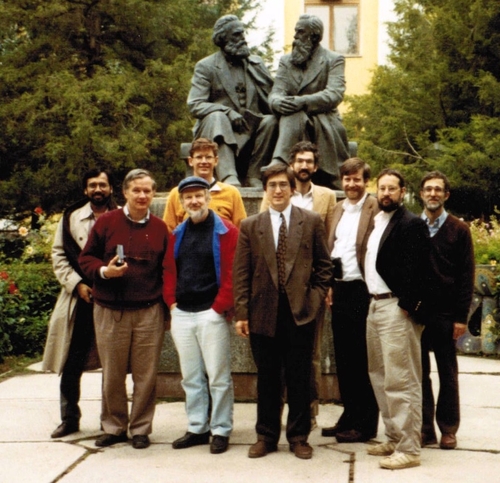The Middle East Council took a group of ten American specialists to Central Asia during the first half of October, spending five days in each of Kazakhstan and Uzbekistan. We visited Alma Ata, Chimkent, Turkestan, Tashkent, and Samarqand.
 Eight of the MEC group in Kazakhstan in front of a Marx & Engels statue, from the left: Shafiqul Islam, Dale Eickelman, Graham Fuller, Patrick Clawson, Assron Nogmanov (the local guide), Daniel Pipes, Mark Katz, Adam Garfinkle, William Fierman. |
The group found major differences between Kazakhstan and Uzbekistan in terms of freedom of expression and free markets, with the former more open than the latter. In contrast to the ubiquitous Marlboro cigarettes in Kazakhstan, we saw almost no foreign products in Uzbekistan; in contrast to the free atmosphere in the former, we constantly bumped up against taboo subjects in the latter. During our visit to Samarqand, in Uzbekistan, the group wrestled with the regional authorities; an official from the governor's office boarded our bus as we entered the city limits and stuck by our side through the entire visit. He tried repeatedly to prevent us from meeting opposition figures (Birlik, the Tajiks), but to no avail. Getting our way against this man took up a substantial portion of our time in Samarqand but it gave us a sense of the new political realities there.
We were generally impressed by the quality of our interlocutors, even if a number of them did talk Sov-speak (that vague, jargon-laden delivery which exists on its own, devoid of the old Marxist-Leninist content). Our three economists found it hard, however, to get hard numbers, especially in Uzbekistan. This points to difficulties for business.
The extraordinary price distortions following on the 340 rubles-per-dollar exchange rate has a profound effect on all aspects of life, wiping out life-savings and creating a host of new opportunities. It also makes Americans in the ex-Soviet Union feel like millionaires - an ice cream cone costs 2 cents and a Kazakh-English phrase book goes for 4 cents.
Central Asia turned out to be far more pleasant than its reputation. The streets of the cities we visited are wide and tree-lined, the markets bursting with fresh produce. Pollution may be endemic, but we did not feel it.
 Some of that fresh produce in a market. |
I went on the trip to understand better the impact of Central Asia's independence on the Middle East, and especially the rivalry between Turkey, Iran, and Pakistan. I returned with a wholly different understanding of the matter. In the first place, those countries are far less significant than Russia, something that is not likely to change for many years to come. Second, statements about Turkey (or Iran or Pakistan) being a model for Central Asia are plain malarkey; the Central Asians are proud of their achievements and are only saying this to curry favor and aid. Put more generally: the impact of Uzbekistan on Turkey is far greater than the other way around.